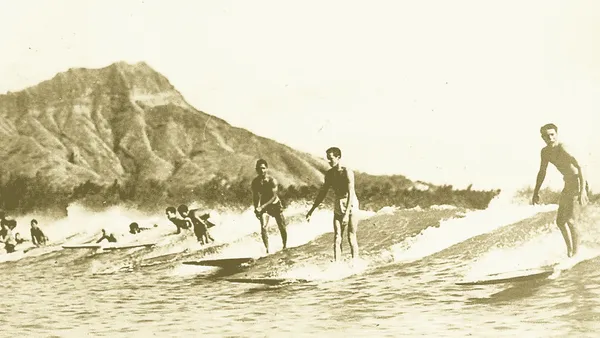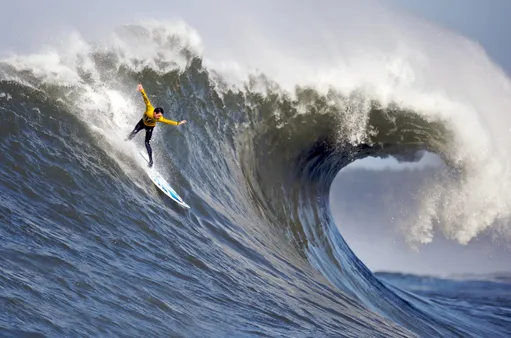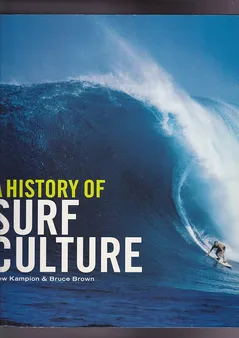Table of Contents
Surfing, a captivating blend of sport, culture, and environmental consciousness, has captivated hearts and minds across the globe. Join Kizworld on an exhilarating journey through The history and culture of surfing, tracing its roots from ancient Polynesian origins to its modern-day popularity. Explore the evolution of surfboards, the thrill of competitions, surfing's impact on popular culture, and the crucial need for environmental stewardship in preserving this beloved sport.
The History and Culture of Surfing: A Timeless Tradition
I. The History of Surfing
The History of Surfing
Surfing's roots can be traced back to ancient Polynesian cultures, where it was a way of life, a means of transport, and a form of spiritual connection with the ocean. The first written records of surfing date back to the 18th century, when European explorers encountered the sport in Hawaii. Surfing was later introduced to the mainland United States in the early 20th century, and it quickly gained popularity as a recreational activity.
The history of surfing is closely intertwined with the history of the surfboard. The first surfboards were made of wood, and they were often very heavy and difficult to maneuver. In the 1950s, the invention of the fiberglass surfboard revolutionized the sport, making it more accessible to a wider range of people. The 1960s saw the rise of professional surfing, and the sport began to gain international recognition.
Today, surfing is a global phenomenon, with millions of people participating in the sport. Surfing competitions are held all over the world, and the sport has been featured in numerous films and television shows. Surfing has also had a significant impact on popular culture, and it has been used as a symbol of freedom and adventure.
Name | Nationality | Years Active |
Duke Kahanamoku | Hawaiian | 1912-1932 |
Tom Carroll | Australian | 1977-1993 |
Kelly Slater | American | 1990-present |
Surfing is a challenging and rewarding sport that can be enjoyed by people of all ages and abilities. It is a great way to get exercise, enjoy the outdoors, and connect with the ocean.
II. Polynesian Surfing Culture
Polynesian surfing culture is the foundation of modern surfing. The Polynesians were the first people to surf, and they developed the sport as a way to connect with the ocean and to catch fish. Surfing was also a way for Polynesians to show their strength and agility.
Polynesian surfboards were made of wood, and they were often very long and heavy. The Polynesians used paddles to help them catch waves, and they would often surf in groups. Surfing was a social activity, and it was a way for Polynesians to connect with each other and with the ocean.
Polynesian surfing culture had a profound impact on the development of modern surfing. The Polynesians were the first people to develop the techniques and skills that are still used by surfers today. They also developed the concept of surfing as a way to connect with the ocean and to enjoy the outdoors.
- Polynesian surfing culture is still practiced today in many parts of the world.
- In Hawaii, surfing is considered to be a sacred sport, and it is often used as a way to connect with the ancestors.
- In other parts of the world, Polynesian surfing culture is seen as a way to celebrate the ocean and to enjoy the outdoors.
Polynesian surfing culture is a rich and vibrant tradition that has had a profound impact on the development of modern surfing. It is a culture that is based on respect for the ocean and for the environment, and it is a culture that celebrates the joy of surfing.
III. The Culture of Surfing
The Culture of Surfing
Surfing is more than just a sport; it's a way of life. It's a culture that embraces the ocean, the waves, and the beach. Surfers are a diverse group of people from all walks of life, but they all share a common love for the sport and the lifestyle that goes with it.
Surfing culture is all about having fun, being active, and enjoying the outdoors. It's about spending time with friends and family, and making memories that will last a lifetime. It's about challenging yourself and pushing your limits, both physically and mentally. And it's about respecting the ocean and the environment.
- Surfing is a global sport, with people from all over the world enjoying the waves.
- Surfing competitions are held all over the world, with the most prestigious being the World Surf League Championship Tour.
- Surfing has been featured in movies, TV shows, and video games.
Surfing is a great way to get exercise, have fun, and connect with nature. It's a sport that can be enjoyed by people of all ages and abilities. If you're looking for a new way to challenge yourself and have some fun, surfing is a great option.
The History of Surfing Culture
Surfing has a long and rich history, dating back centuries. The first surfers were Polynesian people who lived in Hawaii and other Pacific islands. They used surfing as a way to travel, fish, and have fun. Surfing was also an important part of their culture and religion.
In the early 20th century, surfing began to spread to other parts of the world. American and Australian surfers were particularly interested in the sport, and they helped to popularize it around the globe. Today, surfing is a major sport with millions of participants worldwide.
Name | Nationality | Years Active |
Duke Kahanamoku | Hawaiian | 1910-1930s |
Kelly Slater | American | 1990-present |
Stephanie Gilmore | Australian | 2007-present |
Surfing culture has evolved over the years, but it still retains its core values of fun, freedom, and respect for the ocean. Surfers are a passionate and dedicated group of people who love the sport and the lifestyle that goes with it.
The Environmental Impact of Surfing
Surfing can have a negative impact on the environment. The use of surfboards and other equipment can damage coral reefs and other marine habitats. Surfers can also contribute to pollution by leaving trash on the beach or in the ocean.
However, surfers are also some of the most passionate advocates for protecting the environment. They know that the health of the ocean is essential for the survival of their sport. Surfers are working to reduce their environmental impact by using eco-friendly surfboards and other equipment, and by cleaning up beaches and oceans.
Surfing is a great way to connect with nature and appreciate the beauty of the ocean. It's also a great way to get exercise and have fun. If you're looking for a new way to challenge yourself and have some fun, surfing is a great option.
Just remember to be respectful of the ocean and the environment, and to do your part to protect them.
How to Choose the Right Surfboard for Your Skill Level and Style
IV. Surfing Competitions
Surfing Competitions
In the realm of surfing, competitions hold a prominent place, showcasing the skills and talents of surfers from around the world. These events provide a platform for surfers to demonstrate their prowess, push the boundaries of the sport, and inspire awe in spectators. From local contests to prestigious international championships, surfing competitions attract surfers of all levels, fostering a spirit of camaraderie and healthy rivalry.
One of the most renowned surfing competitions is the World Surf League (WSL) Championship Tour, often referred to as the "Olympics of Surfing." This elite tour features the world's top surfers competing in various locations across the globe, battling it out for the coveted world title. Surfers earn points based on their performances in each event, with the overall winner crowned at the end of the season.
Surfing Competition | Location | Frequency |
|---|---|---|
World Surf League (WSL) Championship Tour | Various locations worldwide | Annual |
International Surfing Association (ISA) World Surfing Games | Various locations worldwide | Biennial |
Vans Triple Crown of Surfing | Hawaii, USA | Annual |
Quiksilver Pro France | Hossegor, France | Annual |
Rip Curl Pro Bells Beach | Bells Beach, Australia | Annual |
Another notable competition is the International Surfing Association (ISA) World Surfing Games, which brings together national surfing teams from around the world. This biennial event showcases the diversity of surfing talent and promotes the sport's cultural significance. The ISA also organizes the World Junior Surfing Championship and the World Longboard Surfing Championship, providing opportunities for surfers of all ages and skill levels to compete on an international stage.
Regional and local surfing competitions are also prevalent, offering surfers the chance to gain experience, earn recognition, and qualify for larger events. These competitions foster a sense of community among surfers and help promote the sport at the grassroots level.
Surfing competitions have played a vital role in the growth and popularity of the sport. They showcase the incredible abilities of surfers, inspire aspiring athletes, and provide a platform for the sport to reach a global audience.
- Explore the most prestigious surfing competitions and events
- Get to know the legendary surfers who have shaped the sport
- Discover training tips and techniques to improve your surfing skills
V. Surfing Today
Surfing Today
In the ever-evolving world of surfing, new developments and trends are shaping the sport as we know it.Surfers of all levels are embracing the latest equipment, techniques, and trends to enhance their surfing experience.Whether it's the adoption of advanced surfboard designs, the rise of foiling, or the growing popularity of big-wave surfing, there is something for every surfer to explore and enjoy.Here are some notable aspects of surfing today:
- The increasing popularity of surfing as a recreational activity and professional sport.
- The development of innovative and high-performance surfboards.
- The rise of foiling as a new and exciting way to surf.
- The growing interest in big-wave surfing and other extreme surfing disciplines.
- The emergence of surfing as a more inclusive sport, with a greater focus on diversity, equity, and inclusion.
The global surfing community continues to thrive with events, competitions, and festivals celebrating the sport and lifestyle.From the iconic waves of Hawaii to the rugged coastlines of Australia and the beautiful beaches of California, surfers are chasing swells and riding waves around the world.As surfing continues to evolve, it's clear that the future of the sport is bright, with new innovations and experiences yet to be discovered, and mentioning The History and Evolution of Surfing article for more historical surfing insights.
In addition to the aforementioned developments, the surfing community is also actively engaged in sustainability and environmental initiatives.Surfers are passionate about protecting the oceans and coastlines that they love, and many individuals and organizations are working towards reducing their impact on the environment.From beach cleanups and marine conservation efforts to advocating for sustainable practices, surfers are making a positive contribution to the environment, check our Surfing's Environmental Impact for a deep dive on the topic.
Event | Location | Frequency |
World Surf League Championship Tour | Various locations worldwide | Annual |
Big Wave World Tour | Various locations worldwide | Annual |
Vans Triple Crown of Surfing | Hawaii | Annual |
Quiksilver Pro France | France | Annual |
Rip Curl WSL Finals | California, USA | Annual |
As the surfing world continues to progress, it's exciting to consider what the future holds for the sport.Technological advancements, new surfing techniques, and a growing emphasis on sustainability are all contributing to the evolution of surfing.One thing is for sure: surfing will remain a cherished and captivating sport, enjoyed by people of all ages and backgrounds, also check our related article The Future of Surfing for more insights on this topic.
VI. Surfing: A Timeless Pursuit
Surfing has transcended its origins as a Polynesian pastime to become a global phenomenon, a symbol of adventure, freedom, and environmental stewardship. It is a sport that continues to captivate and inspire, attracting individuals from all walks of life to ride the waves and experience the thrill of gliding across the ocean's surface. As surfing's popularity continues to grow, it is important to strike a balance between enjoying this exhilarating sport and preserving the marine environment that makes it possible. By embracing sustainable practices and promoting ocean conservation, surfers can ensure that future generations can continue to enjoy the waves and the rich cultural heritage associated with surfing.